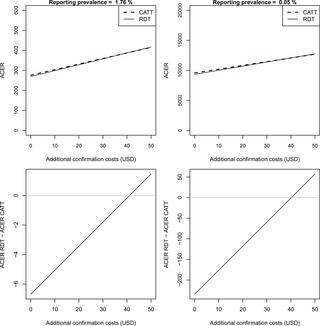PLOS ONE ( IF 3.7 ) Pub Date : 2018-09-21 , DOI: 10.1371/journal.pone.0204335 Paul R. Bessell , Crispin Lumbala , Pascal Lutumba , Sylvain Baloji , Sylvain Biéler , Joseph M. Ndung'u

|
New rapid diagnostic tests (RDTs) for screening human African trypanosomiasis (HAT) have been introduced as alternatives to the card agglutination test for trypanosomiasis (CATT). One brand of RDT, the SD BIOLINE HAT RDT has been shown to have lower specificity but higher sensitivity than CATT, so to make a rational choice between screening strategies, a cost-effectiveness analysis is a key element. In this paper we estimate the relative cost-effectiveness of CATT and the RDT when implemented in the Democratic Republic of the Congo (DRC). Data on the epidemiological parameters and costs were collected as part of a larger study. These data were used to model three different diagnostic algorithms in mobile teams and fixed health facilities, and the relative cost-effectiveness was measured as the average cost per case diagnosed. In both fixed facilities and mobile teams, screening of participants using the SD BIOLINE HAT RDT followed by parasitological confirmation had a lower cost-effectiveness ratio than in algorithms using CATT. Algorithms using the RDT were cheaper by 112.54 (33.2%) and 88.54 (32.92%) US dollars per case diagnosed in mobile teams and fixed health facilities respectively, when compared with algorithms using CATT. Sensitivity analysis demonstrated that these conclusions were robust to a number of assumptions, and that the results can be scaled to smaller or larger facilities, and a range of prevalences. The RDT was the most cost-effective screening test in all realistic scenarios and detected more cases than CATT. Thus, on this basis, the SD BIOLINE HAT RDT could be considered as the most cost-effective option for use in routine screening for HAT in the DRC.
中文翻译:

在刚果民主共和国使用快速诊断检测筛查人类非洲锥虫病的成本效益
已经引入了用于筛选人类非洲锥虫病(HAT)的新的快速诊断测试(RDT),作为锥虫病(CATT)卡凝集测试的替代方法。已经证明,RDT的一个品牌SD BIOLINE HAT RDT具有比CATT更低的特异性,但灵敏度更高,因此要在筛选策略之间做出合理的选择,成本效益分析是一个关键要素。在本文中,我们估算了在刚果民主共和国(DRC)实施CATT和RDT的相对成本效益。流行病学参数和费用的数据是作为一项较大研究的一部分而收集的。这些数据被用来为移动团队和固定医疗机构中的三种不同的诊断算法建模,并且相对成本效益被度量为每例确诊病例的平均成本。在固定设施和流动团队中,使用SD BIOLINE HAT RDT进行参与者筛查并进行寄生虫学确认的成本效益比均低于使用CATT的算法。与使用CATT的算法相比,使用RDT的算法在移动团队和固定医疗机构中诊断的每例病例分别便宜112.54美元(33.2%)和88.54美元(32.92%)。敏感性分析表明,这些结论对许多假设都具有鲁棒性,并且可以将结果缩放至较小或较大的设施,以及一系列患病率。在所有实际情况下,RDT筛查都是最具成本效益的筛查测试,比CATT侦查的病例更多。因此,在此基础上,


























 京公网安备 11010802027423号
京公网安备 11010802027423号